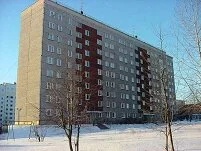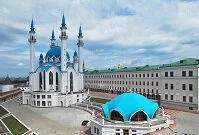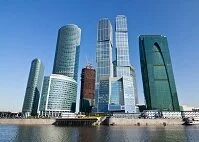
Communist Apartment in Izhevsk
After a brief introduction of Baroque, which includes the Church of the Intercession (1689-1694) in Moscow, St. Petersburg was founded in 1703, moving the capital and the architectural center of the country to Peter the Great's new city. St. Petersburg's architecture is a combination of late Baroque or Rococo and neo-Classicism, but truly has its own distinct look and design.

Kul Sharif Mosque in Kazan
St. Petersburg has dozens of buildings in these styles. Saint Isaac's Cathedral (1818-1858) is in a more pure neo-Classical style, while earlier buildings tend to be primarily in the Rococo style, such as Smolny Cathedral (1748-1764), the Winter Palace (today housing the Hermitage Museum; 1730s-1837), and perhaps the most impressive structure in the St. Petersburg area, Petergof (or Peterhof/Petrodvorets; 1714-1800s). Petergof served as the tsars' Summer Palace and is again in numerous styles, but tends to resemble palaces of Western Europe more than much of St. Petersburg.

Modern Moscow
Throughout history, most Russian architecture has been constructed of wood so has not lasted real long. In any Russian village there are sure to be numerous wooden houses, but undoubtedly the most impressive of these are the churches on Kizhi Island, often referred to as Kizhi Pogost (1700s), which look like many other Russian churches, but are made from wood.
With the rise of communism in the early 1900s, a new architectural style came. This communist style was built for efficiency and use over design and aesthetics, but it now dominates the country. These simple buildings were built at different heights during different leaders' rules, but little else changed over time. It is impossible to visit Russia today without seeing hundreds of these buildings, even in long forgotten Siberian cities, these buildings are impossible to escape.